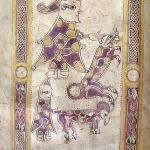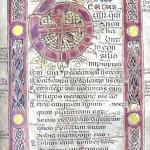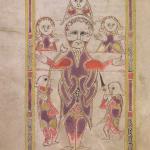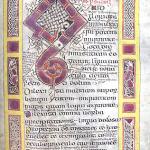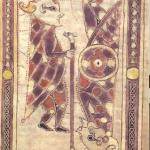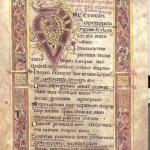PSALTER (IRISH).
Vellum, 10.375 x 7.25, ff. 1 + 98, 30, 31, and 32 lines to a page. 10th cent. ?
(Zimmer says late 10th cent., Bannister says about A. D. 1000), very finely written in an Irish miniscule.
Donor, T. C. S. Priced xls .
From St Martin’s Priory, Dover. At the bottom of f. 3 is:
A:V: Psalterium vetus glosatum ydiomate incognito . . . apprehendite disciplinam
. . . 105. . . 1. . .
A similar inscription and mark on the flyleaf. See Ancient Libraries,
p. 523, etc.
At top of f. 1b : R. Benet (16th cent.). He seems to have been a mayor of Romney. His name occurs in several other manuscripts in this library.
Collation: 1 flyleaf, 112 212 310 414 (14 canc.) 512 610 (9 canc.) 712 810 98.
The first leaf after the flyleaf is numbered 4 in the hand of the Dover librarian, and the numbering runs to 101 in the same hand. The lost leaves at the beginning most likely contained the Prologues.
Contents:
Frontispiece . . . . . . . . . . . . f. (4)1b
Psalter. Gallican 1-50 . . . . . . . . . . (5)2
After Ps. 50 (Misserere mei) follows:
Deus altissime rex angelorum. deus laus omnium elimentorum. deus
gloria et exultatio sanctorum. custodi animas seruorum tuorum.
qui regnas in secula seculorum amen1 .
Benedicte omnia opera.
Confitebor tibi domine (canticum issaiae).
Ego dixi (cant. ezechiae).
f. 35a blank. Frontispiece, 35b.
Ps. 51-100.
After Ps. 100. Deo gratis ago.
Deus quem exercitus canet angelorum. quemque aeclessiae laudat
sanctorum. quem spiritus ymminizat uniuersorum. Misserere
obsecro omnium nostrorum tuorum qui regnas in saecula
saeculorum. Amen.
Canticum annae matris samuelis.
„ mariae sororis moysi.
„ ambacuc prophetae.
Frontispiece . . . . . . . . . . . . 68b
Ps. 101-150 . . . . . . . . . . . . 69
At end of Ps. 150. Finit. amen. finit.
Te dominum de caelis laudamus. Teque omnium regem regum
rogamus. Tibi uni et trino in quem speramus. Cum excelsis
angelis imnum cantamus. per dominum nostrum 7rl’.
Audite caeli.
Ending 101 (98)a. Verso blank.
There are copious glosses in the book: I seem to distinguish two
hands only. The glosses are interlinear and marginal, and are
in Latin and Irish.
At top of f. 2 is an indistinct note.
Argumentum . . . incipit (?) prefatio (?).
Then: Psalmus dauid de increpatione abisolon qui erat impius et
achithophel.
There is a similar argumentum to each psalm.
The psalms are divided into numbered sections, and the end of a
section is apt to be marked with a cross. Thus Ps. 1 is in two
sections, the second beginning at Non sic impii, and the last
verse having a Response prefixed to it2.
Ps. 2 is thus divided: (1) Quare fremuerunt.
ii Disrumpanus uincula.
iii Ego autem constitutus.
R. Dominus dixit ad me. ??
iv Et nunc reges.
Ps. 3 (1) Domine quid multiplicati.
ii Ego dormiui.
R. Domini est salus.
The Irish glosses have been printed by Zimmer, Whitley Stokes, (Goidelica), and W. Stokes and Strachan, Thesaurus Palaeohibernicus I 4-6 (and xiv). One at the beginning of Ps. 51 (f. 36a) is rendered "Beltane to-day that is Wednesday." Beltane, 1st May, fell on Wednesday 28 times during the 9th and 10th cents. The last four occasions were 972, 978, 989, 995. Some of the forms in the glosses, say the editors of theThesaurus Palaeohibernicus, seem to point to a high antiquity; side by side with these are others of a later cast.
The decoration of the book consists of: a. Three full-page pictures.
b. Three borders (opposite the pictures). c. Decorative initials.
The three pictures are well-known specimens of Irish art and afford most striking examples at once of skill in decoration and total inability to draw figures.
I. f. 1b. Border: yellow frame enclosing panels of beautiful interlaced work (white
on black) and serpent patterns (red and white on black): also four circles left blank in C.
of sides, and four square panels of ornament at the angles.
The picture shows- Above: David with one hand touching a beast (lion or bear)
which is on its hind legs on R. with back turned to him. The figures are surrounded
with red dots. Below: David holding the tail of a horned ram on R.
f. 2a has border, with red frame. Eight disks of plain yellow, four squares of yellow
at the angles, and panels of serpentine and interlaced ornament.
2. f. 35b. Border: yellow frame with panels of interlaced work, and squares and
disks in red and vermilion.
The Crucifixion. On the arms of the Cross are two figures with outspread hands
who may be meant for the Virgin and John, or two angels3.
Above Christ's head are the head and ? arms of another figure, probably the Father.
There are red dots in the palms of Christ's hands, and indications of two nails in His
ankles: the upright of the Cross is not shown.
On L. the man with the reed and sponge (Stephaton): the reed is represented as
passing under the bridge of his nose.
On R. Longinus with the spear. The drapery of Christ is purple, and is made into an interlaced pattern under the arms. The arms and legs are coloured red.
Red dots surround the figures.
f. 36. Border: yellow frame with squares of red and panels of serpentine and
interlaced work. Horned beasts occur.
3. f. 68b. Border: yellow frame, squares and disks of yellow, interlaced work in panels.
On L. David holding staff with beast's head and spiked end4.
On R. Goliath, upside down, holding hand to face. A round shield half way down (or up)
his body. The draperies of both are mainly purple in bands separated by white lines, and with disks of red and yellow. Red dots about them.
f. 69a. Border: yellow and red frame of bands which project at the angles and middle of sides: fine panels of interlaced and serpentine ornament.
There is a decorative initial to each psalm. The body of these is usually purple-red, or else black, and they are filled with red, yellow, purple or vermilion. The internal ground is sometimes ornamented with disks of yellow, sometimes with interlaced work. They are uniformly surrounded with red dots, and in one or two cases they have been erased. Many terminate in heads of beasts. Each verse has a plain initial in black filled with purple-red or yellow. These colours usually alternate, but sometimes both are employed.
Coloured facsimilies of the pictures are to be found in Professor Westwood's publications, as follows:
In Palaeographia Sacra Pictoria, no. 18. The Crucifixion, and the beginning of Benedicite.
In Miniatures and Ornaments of A. S. and Irish MSS. Pl. xxx. The two other pictures, the border of Ps. i and the beginning of Ps. i and Ps. ci (text, p. 84).
The colours in all these are lighter and brighter than those of the MS.
Uncoloured reproductions are to be found in many text-books on art.
The book was shown at the Burlington Fine Arts Club in 1908: no. 3
in the Catalogue.
1 On these prayers and the arrangement of the Canticles see an article by the Rev. H. M. Bannister (Irish Psalters) in the Journal of Theol. Studies XII (1910-11), p. 280.
2 In the three last Psalms F is prefixed to nearly every verse.
3 A very similar picture from a Penitential at S. Gallen, Westwood Miniatures, pl. xxviii, shows these figures clearly as two angels with books.
4 Compare a drawing in MS. Cotton Vitellius F. xi, reproduced by Westwood, pl. 51.
The manuscript has been digitized and may be viewed online on the Cambridge University Digital Library.
Negative microfilm in St John's College Library.
J. J. G. Alexander (ed.), A survey of manuscripts illuminated in the British Isles, vol. 1, Insular Manuscripts 6th to the 9th century (London, 1978).
C. 9 was borrowed by Humphrey Wanley in Dec. 1702-Jan. 1703, see his letters in P. L. Heyworth (ed.), Letters of Humphrey Wanley: paleographer and Anglo-Saxonist, librarian, 1672-1726 (Oxford, 1989), pp. 198, 207-8.
With regard to the indistinct note at the top of f. 2, beginning 'Argumentum', Mr A. Rogers suggests 'Argumentum acutae mentis inuentio'.
F. Barlow, 'Monastic Revival', The History of the English speaking peoples, vol. 1, part-work (1969), pp. 261-6.
L. Gjerlow, Antiphonarium Nidrosiensis Ecclesiae (Oslo, 1979).
F. Henry and G. L. Marshall-Micheli, 'A century of Irish illumination, 1070-1170', Proceedings of the Royal Irish Academy, 62 section C, no.5, 101-64.
F. Henry, 'Remarks on the decoration of three Irish Psalters', Proceedings of the Royal Irish Academy 61 (1960) section C, no. 2, 23-40, contains descriptions of this MS as well as reproductions from it.
P. W. Wenger, Irische Miniaturen (Hamburg, 1957), contains reproduction of ff. 35b and 36a with a description opposite.
L. Gougaud, 'The earliest Irish representations of the Crucifixion', Journal of the Royal Society of Antiquaries of Ireland, series 6, vol. 10 (1921), 128-39, plate vii reproduces f. 35b.
Also G. L. Micheli, L' enluminure du haut moyen age et les influences Irlandaises: histoire d'une influence (Brussels, 1939), p. 11.
O. E. Saunders, English illumination (Florence and Paris, 1928), text p. 13, and plates 13 (f. 35b) and 14 (f. 69a, Psalm 101).
P. Emmanuel, Les jours de la passion, poemes (Yonne, 1962), contains reproduction of f. 35b.
E. Heinrich Zimmermann, Die Vorkarolingischen Miniaturen (Berlin, 1916), text pp. 108-9 and 253-4. (The latter includes the description of the MS. which Zimmermann believes to be 2nd half of the 10th cent.) Plate 212 reproduces ff. 1b and 69a, and plate 213, ff. 38b and 68b.
J. A. Herbert, Illuminated manuscripts (London, 1911), p. 82, has a disparaging description of the three full page illuminations.
P. P. O'Neill, 'Some remarks on the edition of the Southampton Psalter Irish glosses in Thesaurus palaeihibernicus, with further addenda and corrigenda', Eriu 44 (1993), 99-103.
K. M. J. Openshaw, 'Weapons in the daily battle: images of the conquest of evil in the early medieval Psalter', Art Bulletin 85 (1993), 17-38.
K. M. J. Openshaw, 'The battle between Christ and Satan in the Tiberius Psalter', Journal of the Warburg and Courtauld Institutes 52 (1989), 14-33.
K. M. J. Openshaw, 'The symbolic illustration of the Psalter: an insular tradition', Arte Medievale, 2nd series, 6:1 (1992), 41-60.
Mildred Budny, 'Deciphering the art of interlace', in Colum Hourihane (ed.) From Ireland coming: Irish art from the early Christian to the late Gothic period and its European context (Princeton, 2001) pp. 183-210.
H. Gneuss, Handlist of Anglo-Saxon manuscripts: a list of manuscripts and manuscript fragments written or owned in England up to 1100 (Tempe, 2001) no. 148.
M. Schapiro, The language of forms: lectures on insular manuscript art (New York, 2005) pp. 83-84, 137.
E. Duncan, 'The Southampton Psalter': a Palaeographical and Codicological Exploration, Anglo-Saxon, Norse & Celtic Manuscript-Studies 4 (Cambridge, 2004).
E. Duncan, 'Contextualising 'The Rouen Psalter': palaeography, codicology, and form', The Journal of Celtic Studies 5 (2005), 17-60.
Exhibited (fols. 68v-69r) at the Fitzwilliam Museum, Cambridge, from 26 July to 11 December 2005. See the exhibition catalogue: P. Binski and S. Panayotova (eds.), The Cambridge Illuminations: Ten Centuries of Book Production in the Medieval West (London: Harvey Miller, 2005) no. 16.
Stella Panayotova (ed.), The Cambridge Illuminations: the Conference Papers (London: Harvey Miller, 2007) p. 16.
Jenifer Ní Ghrádaigh, 'Audience, visuality and naturalism: depicting the crucifixion in tenth-century Irish art' in The mystery of Christ in the fathers of the Church ed. J.E. Rutherford and D. Woods (Dublin: Four Courts Press, 2012)
P.P. O’Neill (ed.) Psalterium Suthantoniense. Corpus Christianorum continuatio mediaevalis; 240. (Turnhout: Brepols, 2012)
P.P. O'Neill 'An Irish Psalter with two lives : the story of the Southampton Psalter' in From medieval to modern : aspects of the western literary tradition ed. Yoko Wada. (Osaka: Kansai University Press, 2017)
D.J. Reilly, 'Meditation, translation, the liturgy, and the medieval illustrated psalter in the west', in: A book of psalms from eleventh-century Byzantium : the complex of texts and images in Vat. Gr. 752, eds. Barbara Crostini & Glenn Peers. Studi e testi 504. (Vatican City, 2016) pp. 569-608.
